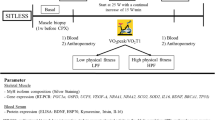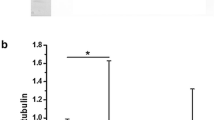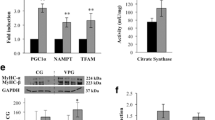Abstract
Purpose
To investigate the effects of strength training on abundances of irisin-related biomarkers in skeletal muscle and blood of untrained young women, and their associations with body mass composition, muscle phenotype and levels of thyroid hormones.
Methods
Eighteen untrained women performed 12 weeks of progressive whole-body heavy strength training, with measurement of strength, body composition, expression of irisin-related genes (FNDC5 and PGC1α) in two different skeletal muscles, and levels of serum-irisin and -thyroid hormones, before and after the training intervention.
Results
The strength training intervention did not result in changes in serum-irisin or muscle FNDC5 expression, despite considerable effects on strength, lean body mass (LBM) and skeletal muscle phenotype. Our data indicate that training affects irisin biology in a LBM-dependent manner. However, no association was found between steady-state serum-irisin or training-associated changes in serum-irisin and alterations in body composition. FNDC5 expression was higher in m.Biceps brachii than in m.Vastus lateralis, with individual expression levels being closely correlated, suggesting a systemic mode of transcriptional regulation. In pre-biopsies, FNDC5 expression was correlated with proportions of aerobic muscle fibers, a relationship that disappeared in post-biopsies. No association was found between serum-thyroid hormones and FNDC5 expression or serum-irisin.
Conclusion
No evidence was found for an effect of strength training on irisin biology in untrained women, though indications were found for a complex interrelationship between irisin, body mass composition and muscle phenotype. FNDC5 expression was closely associated with muscle fiber composition in untrained muscle.





Similar content being viewed by others
Notes
Throughout the manuscript, the term “steady-state” refers to gene expression/hormone abundance measured in biological material sampled at rest (in this study: >48 h since last training session).
Abbreviations
- 18S rRNA:
-
18S ribosomal RNA
- β2m:
-
β2-Microglobulin
- β-a:
-
β-Actin
- BB:
-
musculus Biceps brachii
- DXA:
-
Dual-energy X-ray absorptiometry
- EIA:
-
Enzyme immunoassay
- FM:
-
Fat mass
- FNDC5:
-
Fibronectin type III domain-containing protein 5
- FT3:
-
Free triiodothyronine
- FT4:
-
Free thyroxine
- GAPDH:
-
Glyceraldehyde-3-phosphate dehydrogenase
- LBM:
-
Lean body mass
- MyHC:
-
Myosin heavy chain
- PGC1α:
-
Peroxisome proliferator-activated receptor gamma coactivator 1-alpha
- PolR2A:
-
Polymerase (RNA) II (DNA directed) polypeptide A
- PPIA:
-
Peptidylprolyl isomerase A (cyclophilin A)
- qRT-PCR:
-
Quantitative reverse transcriptase-polymerase chain reaction
- RM:
-
Repetition maximum
- RPL32:
-
Ribosomal protein L32 (RPL32)
- s-irisin:
-
Serum concentrations of irisin
- TBP:
-
TATA box binding protein
- TSH:
-
Thyroid-stimulating hormone
- UBC:
-
Ubiquitin C
- VL:
-
musculus Vastus lateralis
References
Adams GR, Hather BM, Baldwin KM, Dudley GA (1993) Skeletal muscle myosin heavy chain composition and resistance training. J Appl Physiol 74(2):911–915
Adams CM, Suneja M, Dudley-Javoroski S, Shields RK (2011) Altered mRNA expression after long-term soleus electrical stimulation training in humans with paralysis. Muscle Nerve 43(1):65–75. doi:10.1002/mus.21831
Blomstrand E, Ekblom B (1982) The needle biopsy technique for fibre type determination in human skeletal muscle—a methodological study. Acta Physiol Scand 116(4):437–442. doi:10.1111/j.1748-1716.1982.tb07163.x
Bostrom P, Wu J, Jedrychowski MP, Korde A, Ye L, Lo JC, Rasbach KA, Bostrom EA, Choi JH, Long JZ, Kajimura S, Zingaretti MC, Vind BF, Tu H, Cinti S, Hojlund K, Gygi SP, Spiegelman BM (2012) A PGC1-[agr]-dependent myokine that drives brown-fat-like development of white fat and thermogenesis. Nature 481(7382):463–468. doi:10.1038/nature10777
Boström P, Wu J, Jedrychowski MP, Korde A, Ye L, Lo JC, Rasbach Kyle A, Boström EA, Choi JH, Long JZ, Kajimura S, Zingaretti MC, Vind BF, Tu H, Cinti S, Højlund K, Gygi SP, Spiegelman BM (2012) Bostrom et al. reply. Nature 488(7413):E10–E11. doi:10.1038/nature11365
Diez D, Grijota-Martinez C, Agretti P, De Marco G, Tonacchera M, Pinchera A, Morreale de Escobar G, Bernal J, Morte B (2008) Thyroid hormone action in the adult brain: gene expression profiling of the effects of single and multiple doses of triiodo-l-thyronine in the rat striatum. Endocrinology 149(8):3989–4000. doi:10.1210/en.2008-0350
Dytham C (2011) Choosing and using statistics: a biologist’s guide. Wiley Publishing, New Jersey
Ellefsen S, Stensløkken KO (2010) Gene-family profiling: a normalization-free real-time RT-PCR approach with increased physiological resolution. Physiol Genomics 42(1):1–4
Ellefsen S, Stenslokken K-O, Sandvik GK, Kristensen TA, Nilsson GE (2008) Improved normalization of real time RT PCR data using an external RNA control. Anal Biochem 376(1):83–93. doi:10.1016/j.ab.2008.01.028
Ellefsen S, Bliksøen M, Rutkovskiy A, Johansen IB, Kaljusto M-L, Nilsson GE, Vaage JI, Stenslokken K-O (2012) Per-unit-living tissue normalization of real-time RT-PCR data in ischemic rat hearts. Physiol Genomics 44(12):651–656. doi:10.1152/physiolgenomics.00004.2012
Ellefsen S, Vikmoen O, Zacharoff E, Rauk I, Slettaløkken G, Strand TA, Whist JE, Hanestadhaugen M, Vegge G, Fagernes CE, Nygaard H, Hollan I, Rønnestad BR (2014) Reliable determination of training-induced alterations in muscle fibre composition in human skeletal muscle using qPCR. Scand J Med Sci Sports. doi:10.1111/sms.12185
Enerback S (2013) ADIPOSE TISSUE METABOLISM IN 2012 Adipose tissue plasticity and new therapeutic targets. Nat Rev Endocrinol 9(2):69–70. doi:10.1038/nrendo.2012.242
Erickson HP (2013) Irisin and FNDC5 in retrospect: an exercise hormone or a transmembrane receptor? Adipocyte 2(4):289–293
Gundersen K (2011) Excitation-transcription coupling in skeletal muscle: the molecular pathways of exercise. Biol Rev Camb Philos Soc 86(3):564–600. doi:10.1111/j.1469-185X.2010.00161.x
Hanssen KE, Kvamme NH, Nilsen TS, Rønnestad B, Ambjørnsen IK, Norheim F, Kadi F, Hallèn J, Drevon CA, Raastad T (2012) The effect of strength training volume on satellite cells, myogenic regulatory factors, and growth factors. Scand J Med Sci Sports. doi:10.1111/j.1600-0838.2012.01452.x
Hecksteden A, Wegmann M, Steffen A, Kraushaar J, Morsch A, Ruppenthal S, Kaestner L, Meyer T (2013) Irisin and exercise training in humans—results from a randomized controlled training trial. BMC Med 11(1):235
Hopkins WG, Marshall SW, Batterham AM, Hanin J (2009) Progressive statistics for studies in sports medicine and exercise science. Med Sci Sports Exerc 41(1):3–13
Huh JY, Panagiotou G, Mougios V, Brinkoetter M, Vamvini MT, Schneider BE, Mantzoros CS (2012) FNDC5 and irisin in humans: I. Predictors of circulating concentrations in serum and plasma and II. mRNA expression and circulating concentrations in response to weight loss and exercise. Metabolism 61(12):1725–1738. doi:10.1016/j.metabol.2012.09.002
Irrcher I, Adhihetty PJ, Sheehan T, Joseph A-M, Hood DA (2003) PPARγ coactivator-1α expression during thyroid hormone- and contractile activity-induced mitochondrial adaptations. Am J Physiol Cell Physiol 284(6):C1669–C1677. doi:10.1152/ajpcell.00409.2002
Kadi F, Bonnerud P, Eriksson A, Thornell LE (2000) The expression of androgen receptors in human neck and limb muscles: effects of training and self-administration of androgenic-anabolic steroids. Histochem Cell Biol 113(1):25–29
Kim B (2008) Thyroid hormone as a determinant of energy expenditure and the basal metabolic rate. Thyroid 18(2):141–144. doi:10.1089/thy.2007.0266
Kraemer RR, Shockett P, Webb ND, Shah U, Castracane VD (2013) A transient elevated irisin blood concentration in response to prolonged, moderate aerobic exercise in young men and women. Horm Metab Res (EFirst). doi:10.1055/s-0033-1355381
Krämer DK, Ahlsén M, Norrbom J, Jansson E, Hjeltnes N, Gustafsson T, Krook A (2006) Human skeletal muscle fibre type variations correlate with PPARα, PPARδ and PGC-1α mRNA. Acta Physiol (Oxf) 188(3–4):207–216. doi:10.1111/j.1748-1716.2006.01620.x
Lee P, Linderman Joyce D, Smith S, Brychta Robert J, Wang J, Idelson C, Perron Rachel M, Werner Charlotte D, Phan Giao Q, Kammula Udai S, Kebebew E, Pacak K, Chen Kong Y, Celi Francesco S (2014) Irisin and FGF21 Are cold-induced endocrine activators of brown fat function in humans. Cell Metab 19(2):302–309. doi:10.1016/j.cmet.2013.12.017
Lin J, Wu H, Tarr PT, Zhang CY, Wu ZD, Boss O, Michael LF, Puigserver P, Isotani E, Olson EN, Lowell BB, Bassel-Duby R, Spiegelman BM (2002) Transcriptional co-activator PGC-1 alpha drives the formation of slow-twitch muscle fibres. Nature 418(6899):797–801. doi:10.1038/nature00904
Moreno-Navarrete JM, Ortega F, Serrano M, Guerra E, Pardo G, Tinahones F, Ricart W, Fernández-Real JM (2013) Irisin is expressed and produced by human muscle and adipose tissue in association with obesity and insulin resistance. J Clin Endocrinol Metab 98(4):E769–E778. doi:10.1210/jc.2012-2749
Nebreda AR, Porras A (2000) p38 MAP kinases: beyond the stress response. Trends Biochem Sci 25(6):257–260. doi:10.1016/S0968-0004(00)01595-4
Norheim F, Langleite TM, Hjorth M, Holen T, Kielland A, Stadheim HK, Gulseth HL, Birkeland KI, Jensen J, Drevon CA (2014) The effects of acute and chronic exercise on PGC-1α, irisin and browning of subcutaneous adipose tissue in humans. FEBS J 281(3):739–749. doi:10.1111/febs.12619
Norrbom J, Sundberg CJ, Ameln H, Kraus WE, Jansson E, Gustafsson T (2004) PGC-1α mRNA expression is influenced by metabolic perturbation in exercising human skeletal muscle. J Appl Physiol 96(1):189–194. doi:10.1152/japplphysiol.00765.2003
Novelle MG, Contreras C, Romero-Picó A, López M, Diéguez C (2013) Irisin, two years later. Int J Endocrinol 2013:8. doi:10.1155/2013/746281
Pekkala S, Wiklund PK, Hulmi JJ, Ahtiainen JP, Horttanainen M, Pöllänen E, Mäkelä KA, Kainulainen H, Häkkinen K, Nyman K, Alén M, Herzig K-H, Cheng S (2013) Are skeletal muscle FNDC5 gene expression and irisin release regulated by exercise and related to health? J Physiol. doi:10.1113/jphysiol.2013.263707
Plomgaard P, Penkowa M, Leick L, Pedersen BK, Saltin B, Pilegaard H (2006) The mRNA expression profile of metabolic genes relative to MHC isoform pattern in human skeletal muscles. J Appl Physiol 101(3):817–825. doi:10.1152/japplphysiol.00183.2006
Ramakers C, Ruijter JM, Deprez RH, Moorman AF (2003) Assumption-free analysis of quantitative real-time polymerase chain reaction (PCR) data. Neurosci Lett 339(1):62–66
Raschke S, Elsen M, Gassenhuber H, Sommerfeld M, Schwahn U, Brockmann B, Jung R, Wisløff U, Tjønna AE, Raastad T, Hallén J, Norheim F, Drevon CA, Romacho T, Eckardt K, Eckel J (2013) Evidence against a beneficial effect of irisin in humans. PLoS One 8(9):e73680. doi:10.1371/journal.pone.0073680
Roca-Rivada A, Castelao C, Senin LL, Landrove MO, Baltar J, Crujeiras AB, Seoane LM, Casanueva FF, Pardo M (2013) FNDC5/irisin is not only a myokine but also an adipokine. PLoS One 8(4):e60563. doi:10.1371/journal.pone.0060563
Rønnestad BR, Egeland W, Kvamme NH, Refsnes PE, Kadi F, Raastad T (2007) Dissimilar effects of one- and three-set strength training on strength and muscle mass gains in upper and lower body in untrained subjects. J Strength Cond Res 21(1):157–163
Rønnestad B, Nygaard H, Raastad T (2011) Physiological elevation of endogenous hormones results in superior strength training adaptation. Eur J Appl Physiol 111(9):2249–2259. doi:10.1007/s00421-011-1860-0
Ruas Jorge L, White James P, Rao Rajesh R, Kleiner S, Brannan Kevin T, Harrison Brooke C, Greene Nicholas P, Wu J, Estall Jennifer L, Irving Brian A, Lanza Ian R, Rasbach Kyle A, Okutsu M, Nair KS, Yan Z, Leinwand Leslie A, Spiegelman Bruce M (2012) A PGC-1α isoform induced by resistance training regulates skeletal muscle hypertrophy. Cell 151(6):1319–1331. doi:10.1016/j.cell.2012.10.050
Ruijter JM, Ramakers C, Hoogaars WMH, Karlen Y, Bakker O, van den Hoff MJB, Moorman AFM (2009) Amplification efficiency: linking baseline and bias in the analysis of quantitative PCR data. Nucleic Acids Res 37(6):12. doi:10.1093/nar/gkp045
Staron RS, Karapondo DL, Kraemer WJ, Fry AC, Gordon SE, Falkel JE, Hagerman FC, Hikida RS (1994) Skeletal muscle adaptations during early phase of heavy-resistance training in men and women. J Appl Physiol 76(3):1247–1255
Stengel A, Hofmann T, Goebel-Stengel M, Elbelt U, Kobelt P, Klapp BF (2013) Circulating levels of irisin in patients with anorexia nervosa and different stages of obesity—correlation with body mass index. Peptides 39:125–130. doi:10.1016/j.peptides.2012.11.014
Timmons JA, Baar K, Davidsen PK, Atherton PJ (2012) Is irisin a human exercise gene? Nature 488(7413):E9–E10. doi:10.1038/nature11364
Tipton KD, Rasmussen BB, Miller SL, Wolf SE, Owens-Stovall SK, Petrini BE, Wolfe RR (2001) Timing of amino acid-carbohydrate ingestion alters anabolic response of muscle to resistance exercise. Am J Physiol Endocrinol Metab 281(2):E197–E206
Tjørve E, Tjørve KMC, Olsen JO, Senum R, Oftebro H (2007) On commonness and rarity of thyroid hormone resistance: a discussion based on mechanisms of reduced sensitivity in peripheral tissues. Med Hypotheses 69(4):913–921. doi:10.1016/j.mehy.2006.12.056
Untergasser A, Nijveen H, Rao X, Bisseling T, Geurts R, Leunissen JAM (2007) Primer3Plus, an enhanced web interface to Primer3. Nucleic Acids Res 35(suppl 2):W71–W74. doi:10.1093/nar/gkm306
Vandesompele J, De Preter K, Pattyn F, Poppe B, Van Roy N, De Paepe A, Speleman F (2002) Accurate normalization of real-time quantitative RT-PCR data by geometric averaging of multiple internal control genes. Genome Biol 3(7):RESEARCH0034
Vaughan RA, Gannon NP, Barberena MA, Garcia-Smith R, Bisoffi M, Mermier CM, Conn CA, Trujillo KA (2014) Characterization of the metabolic effects of irisin on skeletal muscle in vitro. Diabetes Obes Metab. doi:10.1111/dom.12268
Vegge G, Ronnestad B, Ellefsen S (2012) Improved cycling performance with ingestion of hydrolyzed marine protein depends on performance level. J Int Soc Sports Nutr 9(1):14
Wrann Christiane D, White James P, Salogiannnis J, Laznik-Bogoslavski D, Wu J, Ma D, Lin Jiandie D, Greenberg Michael E, Spiegelman Bruce M (2013) Exercise induces hippocampal BDNF through a PGC-1α/FNDC5 pathway. Cell Metab 18(5):649–659. doi:10.1016/j.cmet.2013.09.008
Acknowledgements
This study was supported by grants 203961 and 222717 to SE from the Regional Science Fund—Innlandet, Norway. The funders had no role in study design, data collection and analysis, decision to publish, or preparation of the manuscript. Thanks to Daniel Hammarström for valuable assistance with statistical analyses. Thanks to students Øyvind Skattebo, Knut Sindre Mølmen, Thomas Fenne, Fredrik Lie Haugen, Amund Løvstad, Trine C. Larsen, Gunnar Disch, Eirik F. Langøy and Elisabeth Hildenes for assistance during intervention follow-up and data sampling.
Conflict of interest
The authors have no conflicts of interest to declare.
Author information
Authors and Affiliations
Corresponding author
Additional information
Communicated by Martin Flueck.
S. Ellefsen, O. Vikmoen, G. Slettaløkken, JE. Whist, H. Nygaard, I. Hollan, I. Rauk, G. Vegge, TA. Strand and BR. Rønnestad member of The Lillehammer Research Center for Medicine and Exercise Physiology.
Electronic supplementary material
Below is the link to the electronic supplementary material.
421_2014_2922_MOESM2_ESM.tif
Figure s1. Expression stability (M) of nine selected reference genes in A) musculus Vastus lateralis (VL) and B) musculus Biceps brachii (BB) following 12 wks of strength training in 17 previously untrained women. M was calculated using GeNorm, as described by Vandesompele et al. (2002). In both VL and BB, B2m and PPIA were found to be the most stably expressed reference genes, ranking them as most suitable for normalization of target gene qRT-PCR data. (TIFF 227 kb)
421_2014_2922_MOESM3_ESM.tif
Figure s2. Per-mg-tissue expression of PPIA in untrained (pre, black columns) and trained (post, white columns) musculus Vastus lateralis (VL) and musculus Biceps brachii (BB). Data were normalized to the external reference gene mw2060, an approach developed by Ellefsen et al. (2008). The effect of training on gene expression was tested using a paired t test. No differences were found between groups. Values are mean ± S.D. (TIFF 72 kb)
421_2014_2922_MOESM4_ESM.tif
Figure s3. Effects of 12 weeks of progressive heavy strength training on steady-state expression of FNDC5, PGC1α splice variants 1 and 4 (s1 and s4), TBP, GAPDH and MyHC2X in A, C) musculus Vastus lateralis (VL) and B, D) musculus Biceps brachii (BB) of 17 previously untrained young women. Strength training was performed as either 3L1U (three sets lower body - one set upper body; n = 7; in A-B) or 1L3U (one set lower body - three sets upper body; n = 10; in C-D). Muscle biopsies were sampled before (pre) and after (post) the training period. Data were normalized to PPIA and are presented as post-training expression relative to pre-training expression, measured as log2-fold change. Effects of training on gene expression were tested on log2-transformed data using paired t tests. * = p<0.05, *** = p<0.001. Data are presented as box plots, with the central line marking the data set median.(TIFF 742 kb)
Rights and permissions
About this article
Cite this article
Ellefsen, S., Vikmoen, O., Slettaløkken, G. et al. Irisin and FNDC5: effects of 12-week strength training, and relations to muscle phenotype and body mass composition in untrained women. Eur J Appl Physiol 114, 1875–1888 (2014). https://doi.org/10.1007/s00421-014-2922-x
Received:
Accepted:
Published:
Issue Date:
DOI: https://doi.org/10.1007/s00421-014-2922-x




